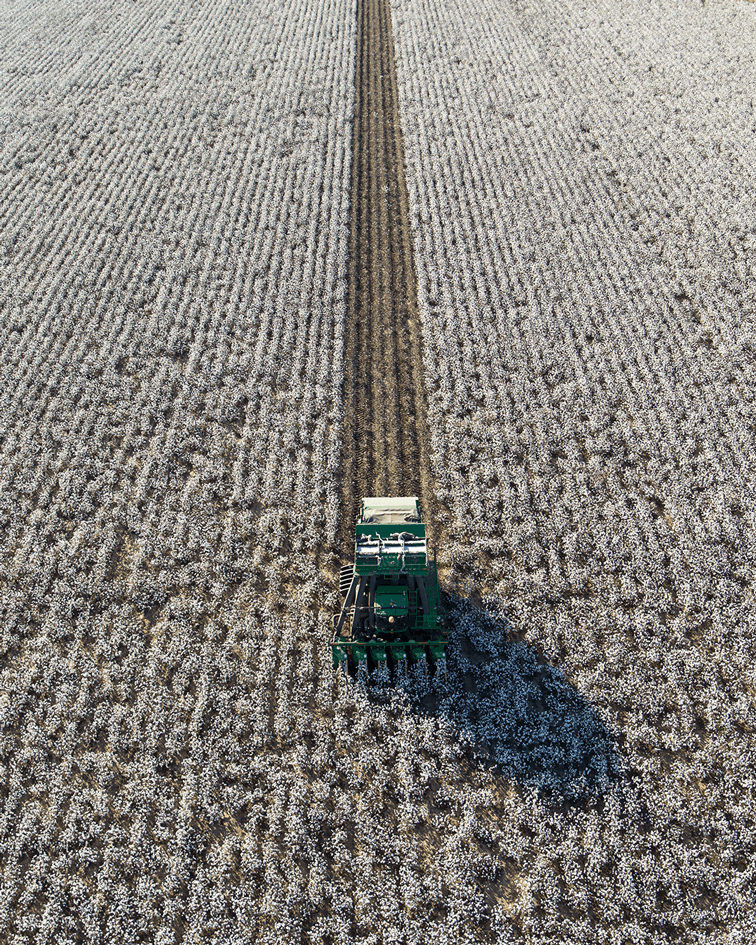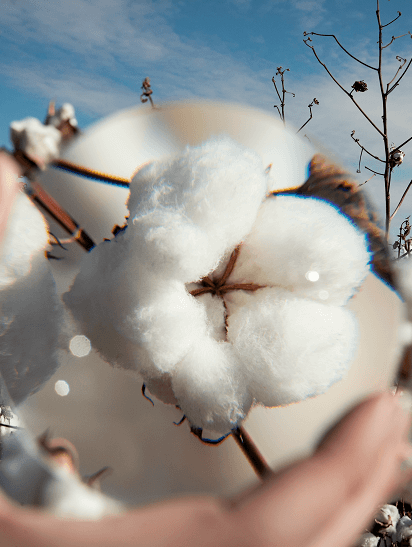
Cotton Farming
Cotton farming has made huge strides toward a sustainable future in the past few decades, and it’s only improving.

| Sustainable Cotton Farming Practices
Growing any kind of crop takes the basics: land and water, but cotton growing doesn’t need too much of either. Thanks to improvements in seed varieties and modern farming techniques, cotton plants are healthier, use less land and water, and have a lower impact on the environment than they did in previous decades. In fact, U.S. cotton farmers now grow almost double the amount of cotton than they did on the same amount of land in 1980, leading to a 30% reduction in land use. Globally, cotton uses only 0.6% of the world’s agricultural lands.1, 2, 3
As for water, did you know that most of U.S. cotton is grown using only rainfall? And half of the global cotton crop also relies solely on rainfall. In fact, only 3% of the world’s agricultural water is used to grow cotton. Because cotton is a heat- and drought-resistant crop, it usually doesn’t need to be irrigated to grow into the fiber we use and love. In fact, it takes more water to grow an acre of regular lawn grass than it takes to grow an acre of cotton.4, 5
Also, cotton is planted in rotation with crops like peanuts and soybeans, which help maintain soil health and cut down on fertilizer use. Cover crops like wheat are also used in winter, to increase soil moisture retention, control weeds, and reduce the presence of insects.6, 3
No- and low-tillage methods also reduce soil erosion.
- 1. Field to Market (2012 V2). Environmental and Socioeconomic Indicators for Measuring Outcomes of On-Farm Agricultural Production in the United States: Second Report, (Version 2), December 2012.
- 2. United Nations Food and Agriculture Organization Statistics. (2016).
- 3. https://cottontoday.cottoninc....
- 4. Field to Market (2016). “Field to Market: The Alliance for Sustainable Agriculture, 2016 Environmental and Socioeconomic Indicators for Measuring Outcomes of On-Farm Production in the United States.”
- 5. https://scienceline.org/2011/0...
- 6. Daystar, J. S., Barnes, E., Hake, K., & Kurtz, R. (2016). Sustainability Trends and Natural Resource Use in U.S. Cotton Production. BioResources, 12(1), 362–392.

Processing the Entire Cotton Plant
While modern farming techniques have improved the farming process, the cotton industry has discovered ways to use more than just the fiber. Now, the entire cotton plant can be used, not just the fluffy boll. Cottonseed becomes a high-quality cow feed, or is pressed into oil for cooking, cosmetics, and soap. Even the cotton “burr,” the seeds, leaves, stems, and hulls of the plant, can be used for mulch, and can also be made into biodegradable packaging.7

Pesticide and Insecticide Use
Even though cotton farming uses pesticides to protect the plant against harm, cotton is not the largest user of agricultural pesticides—it’s actually one of the lowest, accounting for less than 5% of the world’s total pesticide sales. U.S. cotton farmers have reduced their pesticide usage drastically. Plus, with improvements in biotechnology, new cotton varieties, and Integrated Pest Management (IPM) programs, the number of insecticide applications has dropped more than 50% in the United States in the last 30 years. 2017, on average, less than a tenth of an ounce of pesticides were used per pound of cotton. 8, 9
Insecticides are used on cotton to protect the plants that are young and vulnerable, but once the “boll” opens to reveal the fluffy fiber, the plant is mature. With improvements in modern farming techniques, the number of insecticide applications has dropped more than 50% in the United States in the last 30 years.10
- 8. United States Department of Agriculture NASS QuickStats. (2020). Cotton Yield and Production Data.
- 9. https://cottontoday.cottoninc....
- 10. National Cotton Council Beltwide Cotton Conference Proceedings 1987-2016 & Mississippi State University Cotton Insect Losses Reports. https://cottontoday.cottoninc....
| Organic Cotton
Both organic and conventional production systems offer the benefit of providing us with a natural fiber and most of their growing practices are similar. Conventional cotton yields (the amount of fiber per acre) tend to be higher than organic.11, 12
Organic cotton typically yields less fiber per acre because of the difficulty of controlling insects and weeds at scale while following organic guidelines.13 Both organic and conventional production systems can benefit from soil health building practices (regenerative agriculture, use of cover crops, diverse crop rotations, etc.) which have shown to improve soil health.14
Currently, organic cotton represents less than 1% of global cotton production.15
- 11. https://cottontoday.cottoninc....
- 12. United States Department of Agriculture NASS QuickStats. (2020). Cotton Yield and Production Data.
- 13. Oerke, E.-C., & Dehne, H.-W. (2004). Safeguarding production—losses in major crops and the role of crop protection. Crop Protection, 23(4), 275–285.
- 14. Wall, D. H. (2012). Soil ecology and ecosystem services. Oxford University Press.
- 15. https://store.textileexchange....




